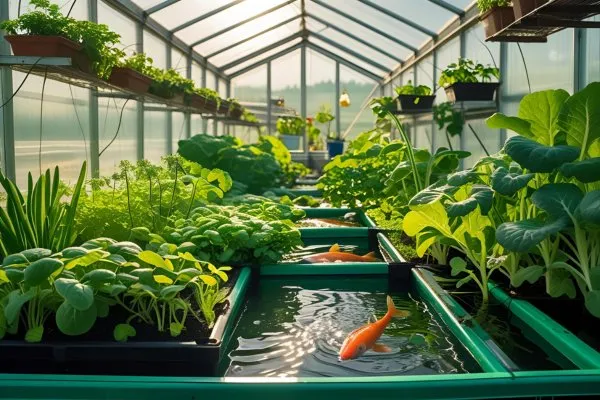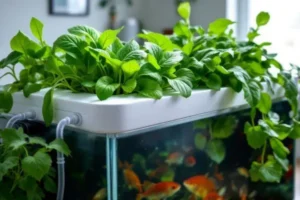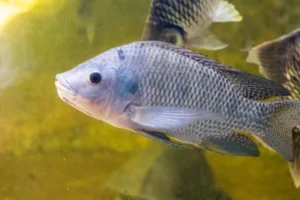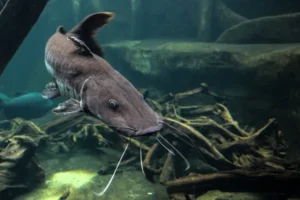The global aquaponic farming market is experiencing unprecedented growth, expanding at 9.3% annually and projected to reach $1.8 billion USD by 2025, according to recent agricultural technology reports. This revolutionary farming method represents more than just a trend—it’s becoming a critical solution to one of humanity’s most pressing challenges.
Traditional agriculture faces mounting pressure from climate change, water scarcity, and the need to feed a growing global population expected to reach 9.7 billion by 2050. Conventional farming consumes 70% of the world’s freshwater resources while contributing significantly to soil degradation and chemical runoff that pollutes waterways. Meanwhile, overfishing threatens marine ecosystems, and urban populations increasingly demand locally-grown, pesticide-free food year-round.
Aquaponic farming emerges as a game-changing solution that addresses these interconnected challenges simultaneously. This innovative approach combines fish farming (aquaculture) with soilless plant cultivation (hydroponics) in a closed-loop ecosystem that mimics natural processes. The result? A sustainable farming method that uses 90% less water than traditional agriculture while producing both protein and vegetables in the same space.
Whether you’re a homesteader seeking food independence, an entrepreneur exploring profitable ventures, or a commercial farmer transitioning to sustainable practices, this comprehensive guide will equip you with everything needed to succeed in aquaponic farming. You’ll discover proven system designs, optimal species selection, economic strategies, and practical solutions to common challenges, enabling you to harness this powerful technology for reliable, year-round food production.
What is Aquaponic Farming?
Aquaponic farming is a revolutionary sustainable agriculture method that integrates aquaculture (fish farming) with hydroponics (soilless plant cultivation) in a symbiotic ecosystem. This closed-loop system creates a natural cycle where fish waste provides essential nutrients for plants, while plants filter and purify water for fish—eliminating the need for soil, synthetic fertilizers, or pesticides.
The Nitrogen Cycle: Nature’s Perfect Engine
The foundation of aquaponic farming lies in the nitrogen cycle, a biological process that converts fish waste into plant-available nutrients. Fish produce ammonia (NH₃) through respiration and waste excretion. Beneficial bacteria, specifically Nitrosomonas species, convert this toxic ammonia into nitrites (NO₂⁻), followed by Nitrobacter bacteria transforming nitrites into nitrates (NO₃⁻)—the primary nitrogen source plants require for healthy growth.
This process typically takes 4 to 6 weeks to establish in new systems, during which bacterial colonies colonize biofilter media at densities reaching 10⁸ to 10⁹ cells per gram of substrate.
Comparative Advantages Over Traditional Methods
Unlike traditional farming, which depletes soil nutrients and requires continuous inputs of water and fertilizers, aquaponic farming operates as a regenerative system. Hydroponic systems depend on synthetic nutrient solutions costing 0.50 to 1.20 USD per square foot annually, while aquaponics generates nutrients naturally through fish feeding.
Water efficiency sets aquaponics apart dramatically—traditional agriculture requires 250 to 300 gallons of water per pound of vegetables produced, while aquaponic systems use only 2 to 6 gallons for the same yield through continuous recirculation.
Sustainability Principles
Aquaponic farming embodies circular economy principles by eliminating waste streams—fish waste becomes plant fertilizer, plants clean water for fish, and both provide food outputs. This biomimicry approach reduces environmental impact while maximizing resource efficiency, creating truly sustainable food production systems capable of operating in any climate with minimal external inputs.
Benefits of Aquaponic Farming
Aquaponic farming delivers transformative advantages that position it as the future of sustainable agriculture, offering compelling benefits across environmental, economic, and productivity dimensions.
Exceptional Water Efficiency
The most striking advantage is water conservation—aquaponic systems use 90% to 95% less water than traditional farming. While conventional agriculture requires 250 to 300 gallons per pound of vegetables, aquaponics needs only 2 to 6 gallons for identical yields. This efficiency stems from closed-loop recirculation, where water continuously cycles between fish tanks and plant beds, with only 2% to 5% daily water loss through evaporation and plant transpiration.
Superior Productivity and Growth Rates
Aquaponic farming achieves 2 to 3 times higher productivity per square foot compared to soil-based agriculture. Lettuce grows from seed to harvest in 28 to 35 days versus 45 to 60 days in traditional systems. Tomatoes can produce 25 to 40 pounds per plant annually, compared to 15 to 20 pounds in conventional farming. This acceleration results from optimal nutrient delivery, consistent growing conditions, and elimination of soil-borne diseases.
Chemical-Free Production
Aquaponic systems eliminate synthetic pesticides, herbicides, and fertilizers entirely. Plants receive balanced nutrition from fish waste, while natural beneficial bacteria maintain system health. This produces genuinely organic food without certification complications, commanding premium prices of 20% to 40% above conventional produce.
Dual Revenue Streams
Unlike traditional farming’s single crop output, aquaponic farming generates income from both fish and vegetables. A 1,000-square-foot commercial system can produce 500 to 800 pounds of fish annually worth 3,000 to 6,000 USD, plus 3,000 to 5,000 pounds of vegetables valued at 15,000 to 30,000 USD.
Environmental Impact
Aquaponics eliminates agricultural runoff, reduces carbon footprint through local production, and creates habitat for beneficial insects. Systems operate year-round in controlled environments, ensuring consistent supply regardless of weather conditions while using 95% less land than traditional farming.
Types of Aquaponic Systems
Aquaponic farming utilizes four primary system designs, each optimized for different scales, crops, and budgets. Understanding these configurations helps determine the ideal setup for your specific goals and constraints.
Media Bed Systems (CHOP Method)
Media bed systems represent the most beginner-friendly approach, utilizing expanded clay pebbles, gravel, or volcanic rock as growing medium. These systems excel at biological filtration while supporting larger plants like tomatoes and peppers. The “CHOP” (Constant Height One Pump) method maintains consistent water levels using a single pump and timer system.
Cost: 15 to 25 USD per square foot Best for: Beginners, fruiting vegetables, systems under 500 square feet Maintenance: Low to moderate
Nutrient Film Technique (NFT)
NFT systems circulate a thin film of nutrient-rich water through sloped channels, making them ideal for leafy greens and herbs. Plants grow in net pots with minimal growing medium, allowing rapid harvests every 28 to 35 days.
Cost: 20 to 35 USD per square foot Best for: Commercial lettuce production, quick-growing crops Yield: 12 to 16 harvests annually
Deep Water Culture (DWC)
DWC systems suspend plant roots directly in aerated, nutrient-rich water, delivering maximum oxygen and nutrients for explosive growth. Raft systems support plants on floating styrofoam boards above fish tanks.
Cost: 10 to 20 USD per square foot Best for: Large-scale commercial operations, leafy greens Productivity: 25% to 40% higher yields than NFT
Vertical Aquaponic Systems
Vertical systems maximize production density using tower structures or stacked growing beds, perfect for urban environments with limited space. These systems can produce 6 to 10 times more per square foot of floor space.
Cost: 40 to 80 USD per square foot Best for: Urban farming, premium herb production Space efficiency: 300 to 600 plants per 4×4-foot footprint
Each system scales differently—media beds suit home operations, NFT works for medium commercial ventures, DWC dominates large commercial farms, and vertical systems optimize urban spaces.
Setting Up Your Aquaponic Farm
Establishing a successful aquaponic farming operation requires systematic planning, proper component selection, and patient system cycling. Following proven protocols ensures optimal performance and long-term sustainability.
System Planning and Sizing
System dimensioning follows the 1:1 to 1:2 ratio rule—for every 1 cubic foot of fish tank volume, provide 1 to 2 square feet of growing bed area. A typical starter system features a 100-gallon fish tank supporting 50 to 100 square feet of growing space, accommodating 20 to 30 adult fish weighing 1 pound each.
Essential Components and Infrastructure
Core components include fish tanks (food-grade polyethylene or fiberglass), water pumps (sized for 1 to 2 tank volumes per hour), air pumps delivering 4 to 6 watts per 100 gallons, PVC plumbing with 1-inch to 2-inch diameter pipes, and biofilter media. Water heaters maintaining 75°F to 82°F are essential in temperate climates.
Quality equipment costs breakdown:
- Fish tank (100-300 gallons): 150 to 800 USD
- Water pump (500-2000 GPH): 80 to 300 USD
- Air pump and stones: 50 to 150 USD
- Plumbing and fittings: 100 to 400 USD
System Cycling Process
Nitrogen cycle establishment requires 4 to 6 weeks before introducing fish. Start by adding ammonia source (fish food or pure ammonia) to reach 2 to 4 ppm concentration. Monitor ammonia, nitrite, and nitrate levels daily using test kits. Complete cycling occurs when ammonia and nitrites reach zero while nitrates accumulate.
Implementation Timeline
Week 1-2: Install infrastructure and fill system Week 3-6: Cycle system and establish bacteria Week 7: Introduce fish at 25% final density Week 8-10: Gradually increase fish population Week 11: Plant seedlings and begin full operation
Investment by Scale
Hobby systems (100-500 square feet): 1,500 to 5,000 USD Commercial systems (1,000+ square feet): 15 to 40 USD per square foot
Proper setup investment ensures reliable operation and maximizes long-term profitability in aquaponic farming.
Best Fish and Plants for Aquaponic Farming
Selecting optimal fish and plant combinations maximizes productivity, profitability, and system stability in aquaponic farming. Strategic species pairing ensures nutritional balance while delivering premium market value.
Top-Performing Fish Species
Tilapia dominates commercial aquaponic farming due to exceptional adaptability, rapid growth (6 to 8 months to market size), and tolerance for varying water conditions. These fish thrive in temperatures from 75°F to 85°F and reach 1 to 2 pounds at harvest, yielding 4 to 8 USD per pound.
Rainbow trout excel in cooler climates (55°F to 65°F), growing to 12 to 16 inches in 12 to 14 months. Premium trout commands 8 to 12 USD per pound, making them ideal for high-value operations.
Channel catfish offer cold tolerance and disease resistance, reaching 1 to 3 pounds in 18 to 24 months. They tolerate crowded conditions and produce consistent waste output for plant nutrition.
High-Value Plant Selection
Leafy greens provide fastest returns—lettuce, spinach, and kale harvest in 28 to 45 days, generating 2 to 4 USD per square foot monthly. Herbs like basil, cilantro, and mint command premium prices of 12 to 20 USD per pound fresh.
Fruiting plants including tomatoes, peppers, and cucumbers require longer establishment (60 to 90 days) but produce continuously for 6 to 12 months, yielding 8 to 15 USD per square foot annually.
Optimal Stocking Densities
Fish density should not exceed 1 pound per 5 to 10 gallons in mature systems. Start with 50% target density, gradually increasing as bacterial colonies establish. Plant spacing varies—leafy greens at 6-inch centers, herbs at 4-inch centers, fruiting plants at 12 to 18-inch centers.
Crop Rotation Strategy
Implement 3-week staggered plantings for continuous harvests. Dedicate 60% of space to fast-growing greens, 25% to herbs, and 15% to fruiting plants. This rotation ensures consistent cash flow while maintaining optimal nutrient cycling throughout your aquaponic farming operation.
Water Management and System Maintenance
Proper water management forms the foundation of successful aquaponic farming, requiring consistent monitoring and proactive maintenance to ensure optimal fish health and plant productivity.
Critical Water Parameters
pH levels must remain between 6.8 to 7.2 for optimal nutrient availability and fish comfort. Ammonia (NH₃) should stay below 0.5 ppm—levels exceeding 2 ppm prove toxic to fish. Nitrites (NO₂⁻) must remain under 0.5 ppm, while nitrates (NO₃⁻) should maintain 10 to 40 ppm for plant nutrition.
Temperature control varies by species—tilapia thrive at 78°F to 82°F, while trout prefer 58°F to 65°F. Dissolved oxygen requires minimum 5 to 6 ppm through continuous aeration.
Essential Monitoring Tools
Digital test kits provide accurate readings—API Master Test Kit (25 to 35 USD) covers basic parameters, while digital pH meters (50 to 150 USD) ensure precision. Thermometers, TDS meters measuring total dissolved solids, and dissolved oxygen meters complete the monitoring arsenal.
Daily and Weekly Maintenance Schedule
Daily tasks include visual fish health checks, water temperature monitoring, and feeding fish 1% to 2% of body weight. Weekly responsibilities encompass comprehensive water testing, cleaning pump intakes, harvesting mature plants, and recording system performance data.
Monthly maintenance involves cleaning biofilters, replacing 10% to 20% of system water, and calibrating test equipment.
Common Problem Solutions
Cloudy water indicates bacterial bloom—reduce feeding and increase aeration. High ammonia requires immediate water changes and reduced fish density. Algae growth signals excess nutrients—reduce lighting to 12 to 14 hours daily and increase plant density.
pH fluctuations stabilize using crushed coral or potassium hydroxide for increases, or phosphoric acid for decreases.
Operational Costs
Monthly expenses average 0.50 to 1.50 USD per square foot, including electricity (15 to 40 USD), fish feed (20 to 60 USD), and replacement supplies (10 to 25 USD). Proper maintenance prevents costly system failures while maximizing aquaponic farming profitability and sustainability.
Economic Analysis and Profitability
Aquaponic farming presents compelling financial opportunities, with well-managed commercial operations achieving sustainable profitability through dual revenue streams and optimized resource utilization.
Initial Investment and Setup Costs
Commercial aquaponic farming systems require 15 to 40 USD per square foot initial investment. A 1,000 square foot operation typically costs 25,000 to 35,000 USD, including greenhouse structure (8,000 to 12,000 USD), fish tanks and grow beds (6,000 to 10,000 USD), pumps and aeration (3,000 to 5,000 USD), and monitoring equipment (2,000 to 4,000 USD).
Operating Expenses
Monthly operational costs average 0.75 to 1.25 USD per square foot. Key expenses include:
- Electricity: 200 to 500 USD monthly for pumps, aeration, and lighting (30% to 40% of total costs)
- Fish feed: 150 to 350 USD monthly with 1.5:1 to 2:1 feed conversion ratios
- Labor: 500 to 1,200 USD monthly for maintenance, harvesting, and monitoring
- Consumables: 75 to 150 USD monthly for seeds, testing supplies, and supplements
Revenue Projections
A 1,000 square foot aquaponic farming system generates:
Plant production: 3,000 to 5,000 pounds annually of leafy greens selling at 3 to 6 USD per pound, yielding 9,000 to 30,000 USD revenue.
Fish production: 600 to 900 pounds annually of tilapia or trout at 4 to 8 USD per pound, generating 2,400 to 7,200 USD additional revenue.
Total annual revenue: 11,400 to 37,200 USD with proper market positioning.
Return on Investment
Break-even typically occurs within 18 to 36 months. Net profit margins range from 25% to 45% after the second year, with ROI reaching 30% to 60% annually for optimized operations.
Business Model Optimization
Direct-to-consumer sales command premium pricing—farmers markets yield 4 to 8 USD per pound for organic greens. Restaurant partnerships provide stable volume contracts, while CSA programs ensure predictable cash flow through advance payments.
Value-added products like herb blends or smoked fish increase margins by 40% to 70%. Successful aquaponic farming operations diversify revenue streams while maintaining consistent quality and supply reliability.
Common Challenges and Solutions
Aquaponic farming operations face predictable challenges that experienced growers address through systematic monitoring and proactive management strategies.
Water Quality Fluctuations
pH instability represents the most frequent challenge, with acceptable ranges between 6.8 to 7.2. Solution: Install automated pH controllers (150 to 400 USD) or manually adjust using potassium hydroxide (raise pH) or phosphoric acid (lower pH) in 0.1 increments.
Ammonia spikes above 0.5 ppm stress fish and indicate insufficient biofilter capacity. Solution: Reduce feeding by 50% for 3 to 5 days, increase aeration, and add beneficial bacteria supplements (25 to 45 USD per bottle). Emergency water changes of 25% to 30% provide immediate relief.
Nutrient Deficiencies
Iron deficiency manifests as yellowing leaves (chlorosis) in 60% to 70% of aquaponic farming systems. Solution: Add chelated iron supplements at 1 to 2 ppm weekly (15 to 25 USD per month). Potassium deficiency appears as brown leaf edges—supplement with potassium sulfate at 10 to 20 ppm.
Calcium deficiency causes blossom end rot in tomatoes. Solution: Foliar calcium sprays or calcium chloride additions maintaining 50 to 80 ppm levels.
System Component Failures
Pump failures threaten entire systems within 4 to 6 hours. Solution: Install backup pumps (75 to 200 USD) with automatic switching systems. Maintain spare impellers and seals (20 to 50 USD).
Power outages risk fish mortality in 2 to 4 hours without aeration. Solution: Battery backup systems (300 to 800 USD) or portable generators providing 8 to 12 hours emergency power.
Pest and Disease Management
Aphids and whiteflies attack 40% to 50% of indoor systems. Solution: Introduce beneficial insects like ladybugs (40 to 60 USD per release) or use neem oil treatments (2 to 4 ml per liter).
Root rot in plants indicates poor water circulation. Solution: Increase flow rates to 1 to 2 GPM per grow bed and improve drainage.
Fish diseases like ich require salt treatments at 1 to 3 ppt concentration for 10 to 14 days, while maintaining careful monitoring of plant tolerance.
Conclusion
Aquaponic farming represents a revolutionary approach to sustainable food production, combining the efficiency of hydroponics with the protein benefits of aquaculture. This comprehensive guide has demonstrated that successful aquaponic farming is achievable for beginners and profitable for commercial operations.
From understanding the symbiotic nitrogen cycle to mastering water management, aquaponic farming offers 90% water savings compared to traditional agriculture while producing both fresh vegetables and protein-rich fish. Whether you’re implementing a simple media bed system in your backyard or scaling a commercial NFT operation, the principles remain consistent: maintain water quality between 6.8 to 7.2 pH, ensure adequate aeration, and balance fish feeding with plant nutrient demands.
The economic analysis reveals promising returns, with commercial systems achieving 25% to 45% profit margins and ROI within 18 to 36 months. While challenges like pH fluctuations and nutrient deficiencies exist, the solutions are well-documented and manageable through proper monitoring and preventive maintenance.
Aquaponic farming addresses critical global issues: food security, water scarcity, and sustainable agriculture. As technology advances with IoT monitoring and automated systems, accessibility continues improving for farmers worldwide.
Ready to start your aquaponic farming journey? Begin with a small-scale system to master the fundamentals, then scale based on your goals and market opportunities. The future of sustainable food production starts with your first step into aquaponics.
Frequently Asked Questions (FAQ)
How much space do I need to start aquaponic farming?
You can begin with as little as 32 square feet for a backyard system producing 20 to 30 pounds of vegetables monthly. Commercial operations typically require 500+ square feet for profitability.
What’s the minimum budget for aquaponic farming?
DIY backyard systems start at 500 to 1,500 USD, while commercial setups require 15,000 to 40,000 USD for 1,000 square feet. Operating costs average 0.75 to 1.25 USD per square foot monthly.
How long before I can harvest from my aquaponic farm?
Leafy greens like lettuce harvest in 4 to 6 weeks, herbs in 3 to 4 weeks, and fruiting plants like tomatoes in 8 to 12 weeks. Fish reach market size in 6 to 9 months depending on species.
Can aquaponic farming work in cold climates?
Yes, with greenhouse protection maintaining 65°F to 75°F water temperatures. Heating costs add 0.20 to 0.50 USD per square foot monthly in winter.
What’s the biggest mistake beginners make?
Overstocking fish or overfeeding, causing ammonia spikes above 0.5 ppm. Start with 1 pound of fish per 10 gallons and feed only what fish consume in 5 minutes.
Is aquaponic farming organic?
Most aquaponic systems qualify as organic, though certification varies by region and requires approved fish feed and pest management practices.



